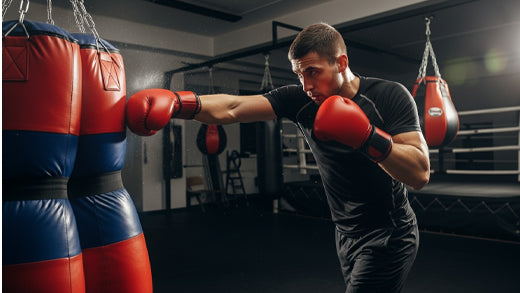Every boxer knows that finding an ideal punching bag filler can make or break their training experience, from its feel, movement, and resistance, depending on whether you throw light jabs or power hooks. Each filler type impacts performance differently. For example, a boxing bag with sand delivers harder resistance, while a punching bag with water provides more rebound and fluid motion.
Sting Sports designs boxing equipment to meet the individual needs and preferences of our users. If you need assistance choosing which filler combines power with comfort for optimal training results, here is an in-depth breakdown that shows exactly how each option performs under real training conditions.
Punching Bag with Water; Fluid Motion and Realistic Impact
A boxing bag filled with water is created to simulate the resistance of hitting a human body. It provides a natural rebound that enables your fists to adjust easily with each swing. Since water flows within the bag, it evenly absorbs the shock, reducing the tension on your wrists and shoulders, which is beneficial for every boxer when they have to train extensively.
Advantages of Water-Filled Punching Bags:
-
Realistic impact similar to live sparring
-
Easy setup and adjustable weight
-
Safe for hands and joints
-
Portable, simply drain when needed
Water-filled bags are ideal for beginners, cardio-focused fighters, or anyone prioritizing rhythm and speed. They’re also great for home setups where space and convenience matter. If you have a limited space, use Punching Bags for Small Spaces and home gyms that complement compact environments without compromising on performance.
Punching Bag with Sand: Heavy Resistance and Raw Power
For those who love intensity, a punching bag with sand is built to challenge. The tightly packed filler creates a dense structure, giving the bag minimal swing and maximum resistance. Each punch demands force and precision, making it a favourite for professional boxers or anyone training for knockout power.
Advantages of Sand-Filled Punching Bags:
-
Increases strength and punching power
-
Stable and less likely to sway
-
Highly durable and long-lasting
-
Builds better body control and stamina
However, sand for punching bag setups can compact over time, creating a hard base. Regular mixing helps maintain consistency, ensuring you get the same resistance throughout. Many athletes combine this type of heavy training with lighter sessions, striking a balance between power and mobility.
If you’re analyzing types of punching bags for boxing based on filler and design, understanding how sand influences weight and structure helps you make smarter training decisions.
Water vs Sand: A Quick Comparison
|
Feature |
Punching Bag with Water |
Punching Bag with Sand |
|
Weight |
Adjustable and portable |
Fixed, heavy, and stable |
|
Impact Feel |
Realistic and forgiving |
Dense and powerful |
|
Swing |
Moves naturally |
Minimal swing |
|
Setup |
Quick to fill or drain |
Harder to adjust once filled |
|
Best For |
Technique, endurance, and cardio |
Power and strength training |
Understanding Punching Bag Fillers
Many new boxers often ask, "What are punching bags filled with?" The most common materials include water, sand, fabric scraps, or a blend of foam and rubber pellets. Each filler type affects performance differently. For example, a boxing bag with sand delivers harder resistance, while a boxing bag with water provides more rebound and fluid motion.
If you want to experiment, you can even mix fillers. Some professionals use water for the base and foam on top, creating a balance between density and comfort.
Choosing the Right Filler for Your Goals
Your training style should determine your choice:
-
For realistic motion and safer impact, pick a water bag punching setup.
-
For stronger resistance and controlled movement, go with a heavy bag with sand.
-
For hybrid training, alternate between both, use a punching bag with a water base for technique drills and a sand-filled one for strength conditioning.
Remember, consistency matters more than the filler itself. With the proper bag setup and steady routine, both options can transform your punching precision, endurance, and confidence.
Why Sting Sports Recommends Balanced Training
At Sting Sports, we’ve worked with world-class athletes who prefer using both a punching bag with sand and a boxing bag with water in rotation. This approach allows boxers to fine-tune different aspects of their game, including speed, accuracy, and power, without overtraining or risking injury.
Our durable punching bags are designed to handle both fillers with ease. Whether you want a heavy resistance workout or a flexible cardio session, your training equipment should adapt to your intensity, not limit it.
Final Thoughts
Choosing either a punching bag with water or one filled with sand depends on what best meets your fitness goals; neither has an obvious advantage over the other, and both offer distinct advantages that will help improve form, balance and strength development.
Boxing bags with water provide comfort and movement that simulate real opponents, while punching bags with sand keep your strikes grounded and strengthen your base. Balance is at the core of great boxing; both options offer this opportunity.
Explore Sting Sports to find high-performance equipment suitable for your next workout, and discover the ideal punching bag and other boxing gear.
FAQs
1. What are punching bags usually filled with?
Punching bags may be filled with water, sand, foam, or cloth. The filler is what defines the weight of the bag, the swing, and the general feel of the bag during impact.
2. Which is better for filling a punching bag: water or sand?
Both are excellent based on your requirements. Water offers natural movement and protects joints, and sand offers greater resistance and develops raw strength.
3. Is it possible to switch between water and sand fillers?
Yes, provided your bag is refillable. Certain punching bag fillings can be easily replaced, providing you with training flexibility.




